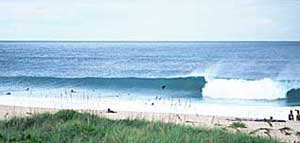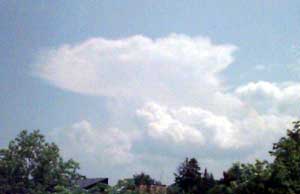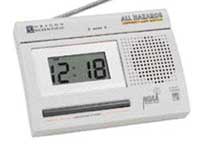Boating & Rough Weather Part 2: Avoiding Bad Weather
Boating & Rough Weather Part 2: Avoiding Bad Weather
Last week we learned some basic techniques to stay in tune with the weather and how to perform fairly accurate short-term forecasts. This week we will look at what types of threats exist to boaters, how to respond to these threats, and learn some additional techniques to hone your weather forecasting abilities.
The majority of boats are designed to be seaworthy in conditions far worse than you'd want to get caught. However, all vessels have a certain point when their ability to stay afloat becomes compromised and you must avoid the conditions that might put your vessel in peril. In Part Three, we will look at what you must do on your vessel to assure the optimum seaworthiness of the boat, but I wanted to point out now that many times the reason for a boat's sinking is preventable. Let's first take a look at some of the hazards.
Lightning
I suggest that if you boat in an area with frequent lightning, that you read all you can on the subject and learn how to reduce the chances of getting struck. The best way is to stay off the water during periods of peak lightning. My basic rule of thumb is that if I can see lightning or hear thunder within ten miles, I lay my graphite fishing rod down and head back to port. Lightning is produced in Cumulonimbus clouds (thunderheads) and if you see the development of these clouds, there is also a good chance lightning will also develop. The faster the cloud develops vertically, the more intense the lightning seems to be. My advice is don't take any chances with lightning and seek safety.
Wind
Wind is not usually a threat in itself, but the effects of the wind on the hull and rigging can drastically reduce maneuverability and headway. The more area of the boat exposed to the wind will act like a sail and will alter the handling of the boat. The greatest effect is felt when trying to dock your boat. In open water the effects are far less because of the increased leeway, however, the psychological effect of the wind whistling, or howling in the rigging can be frightening. In addition, when the wind drives the rain, visibility can be hindered. The wind's effect on the water brings a greater concern…waves.
Waves
 Wave height does not always mean danger, however, the period of the wave can signal danger or relative safety for any given vessel. A long wave period of about twelve seconds or more is usually associated with a swell and would not be a threat unless the wave height started to match or surpass the period. A six-foot high wave with a twelve second period is navigable in deep water, but a six-foot wave with a six second period could cause any boat under forty-feet some anguish. If the wave height and period are the same, then you can expect short steep breaking waves. If the height surpasses the period, the situation is ugly and many boats might founder. However if the wave height is of a ratio of 1:2 or more, then you can expect to find a navigable sea-state.
Wave height does not always mean danger, however, the period of the wave can signal danger or relative safety for any given vessel. A long wave period of about twelve seconds or more is usually associated with a swell and would not be a threat unless the wave height started to match or surpass the period. A six-foot high wave with a twelve second period is navigable in deep water, but a six-foot wave with a six second period could cause any boat under forty-feet some anguish. If the wave height and period are the same, then you can expect short steep breaking waves. If the height surpasses the period, the situation is ugly and many boats might founder. However if the wave height is of a ratio of 1:2 or more, then you can expect to find a navigable sea-state.
Waves versus Swell
When the wind hits the water, first ripples are formed, then small wavelets. If the wind stays constant for a pronounced fetch, then the wavelets will form into waves and then into swells. Swells are waves that have become efficient in their shape and can travel for thousands of miles losing very little of their energy. Swell is usually not a problem to the mariner because the wave height is usually far less than the period. However, once the swell reaches shallow water, then the wave will break and cause surfers' great delight, but boaters a bad headache.
Rain
Rain is only a problem if it decreases your visibility or if the volume of the rain overwhelms your boat's ability to discharge water. It is very rare for a boat underway to sink from rain, but it has happened. Most likely the boat is left unattended at dock with a dead battery to be the victim of deluge induced sinking.
Waterspouts
Waterspouts are tornados over the water, but are usually not a hazard to boaters unless you get caught up in one. While a tornado will suck up a variety of debris that can inflict harm, waterspouts only have water and the occasional fish to avoid. Some waterspouts can grow large and have high wind velocities, so they are best to avoid if possible. You can determine the direction a waterspout is moving by looking at the cumulonimbus cloud it dropped from and what direction the cloud is moving. The spout will wobble, but usually move in a general direction, many times northeast.
Hail
 Hail can damage just about any boat. If hail does fall, get under any cover you can find. If you are incapacitated you reduce your chances of survival. I can count the number of hailstorms I've experienced at sea on one hand, but remember each episode vividly. I will never forget that hail is only associated with cumulonimbus clouds. In fact, just about all the nasty stuff from the sky; lightning, hail, tornadoes, waterspouts and micro-bursts all come from one cloud, the cumulonimbus. Learn to recognize this cloud and stay away from them.
Hail can damage just about any boat. If hail does fall, get under any cover you can find. If you are incapacitated you reduce your chances of survival. I can count the number of hailstorms I've experienced at sea on one hand, but remember each episode vividly. I will never forget that hail is only associated with cumulonimbus clouds. In fact, just about all the nasty stuff from the sky; lightning, hail, tornadoes, waterspouts and micro-bursts all come from one cloud, the cumulonimbus. Learn to recognize this cloud and stay away from them.
Buy's Ballot Law
There is a clever way to determine the direction of a low pressure system called Buy's Ballot Law and is simply stated: Put your back to the wind and extend your left arm to the side. You left arm will be pointing to the direction of low pressure. Low-pressure systems have a cyclonic motion with winds that rotate counter-clockwise and move to the center. High-pressure air moves from the center out towards low pressure in a clockwise motion. This can help you determine your location in relation to the advancing storm. In North America, weather systems tend to move in general from east to west. In addition because of how the lows form in relation with high pressure areas, the squall lines along the frontal systems will move from the southwest to the northeast. These guidelines are very general but many times fit this pattern.
If, for example, you start your day at position A (above) and the wind is blowing from the southeast, then you could expect the low to move in your general direction and the weather will start to change for the worse. The same can apply for position D, however, the storm conditions will usually be less severe. One thing to keep in mind is that the southeast side of a cumulonimbus cloud is where a tornado or waterspout will usually spawn. If you are in position B with a northeasterly wind, then you are probably experiencing some pretty nasty weather while position C the wind is from the northwest and the sky is filled with cumulous clouds and only the threat of a slight shower remains.
My personal formula for a successful day of boating involves obeying the following guidelines:
Obtain a three-day weather forecast to determine the overall picture for your day of boating. Three-day forecasts are usually fairly accurate and you can decide ahead of time if conditions are expected to be favorable.
Obtain a weather forecast the night before your day on the water and look for any changes.
Wake-up early, stick your head outside and look at the sky, smell the air and see if you can't get a gut feeling on the weather for the day. Also listen to NOAA for any late breaking changes.
Keep your eye on the sky throughout the day.
Be willing to change your plans to accommodate the weather. Also don't cave in to peer pressure. If you don't feel good about being on the water, then head back to port. The fish will always be there another day.
Keep clear skies and water between you and safety. If your route becomes impassable, then have several alternative havens of sanctuary.
Recently I had the fortunate experience of forecasting the weather almost perfectly and was able to enjoy a pleasant day of boating while others didn't fair as well. The weekend began of Wednesday with a three-day weather outlook provided by several different weather web sites in addition to the NOAA forecast. The forecast called for a stationary front to finally give way and slowly sink south, ushering in ideal conditions for the development of thunderstorms.
 Friday night I checked all the weather sites again and listened to NOAA and the forecast was calling for partly sunny skies, warm temperatures in the eighties with a southwesterly wind 8-12 knots and a thirty- percent chance of rain. Saturday morning the air was thick and already a warm seventy degrees. Throughout the day, cumulus clouds where puffing up to the north and west of our position. I was concerned because the bottom of the clouds where very low to the water and the vertical development was quick. Most of the clouds didn't pose a threat, but there were two about twenty miles away to the west that had developed into cumulonimbus clouds.
Friday night I checked all the weather sites again and listened to NOAA and the forecast was calling for partly sunny skies, warm temperatures in the eighties with a southwesterly wind 8-12 knots and a thirty- percent chance of rain. Saturday morning the air was thick and already a warm seventy degrees. Throughout the day, cumulus clouds where puffing up to the north and west of our position. I was concerned because the bottom of the clouds where very low to the water and the vertical development was quick. Most of the clouds didn't pose a threat, but there were two about twenty miles away to the west that had developed into cumulonimbus clouds.
I made a few scans around the horizon to make sure nothing was sneaking up from behind and felt comfortable with the current situation. I had a clear path between where we were fishing and my port. At the same time, I took the opportunity to plan out where I might run to safety if for some reason my path back to port was blocked for any reason. One thing boating has taught me is to have back-up plans for my back-up plans, and then maybe another plan in case the first three go awry.
Constant Bearing/Decreasing Range
I kept my eye on those two systems and at one point thought they had burned away, but realized that a layer of lower clouds was blocking my view of a very large thunderhead. When the lower clouds cleared, I decided that the cloud had never changed its bearing and was increasing in size dramatically. That could mean only one thing and that is the developing cell was moving straight towards me. "Time to head in," I announced much to the groan of my customers. They had been really nailing the redfish and trout and didn't want to leave. I pointed at the looming thunderhead and finally all agreed it was best to head in.
On avoiding collisions with anything including storms and other boats the phrase "Constant Bearing and Decreasing Range" is a valuable thing to remember. If an object is maintaining a constant bearing, or in other words is not moving either toward the left or right of you, then that object is either sitting still or moving away from or towards you. If the object gets larger or appears to be getting closer, then the range is decreasing and there is a very good chance you will collide with the object. A hand-bearing compass is an excellent tool to make quick bearing checks on objects.
We got back to the dock and had just finished tying the lines and unloading the gear when the cell was almost directly overhead. We headed down the dock and got into my truck when the sky unleashed a torrential downpour. One of my customers said, "Boy you really timed that right, I'd hate to be out there now!" I thought about some of the other boats still fishing that we passed heading in and wondered what they were up to. Of course I haven't always been so lucky and have been one of those unfortunate souls who get caught out in the bad stuff. Next week we'll take a look at what to do when that dreaded day arrives.
Until next time,
Keep an eye on those clouds!

|